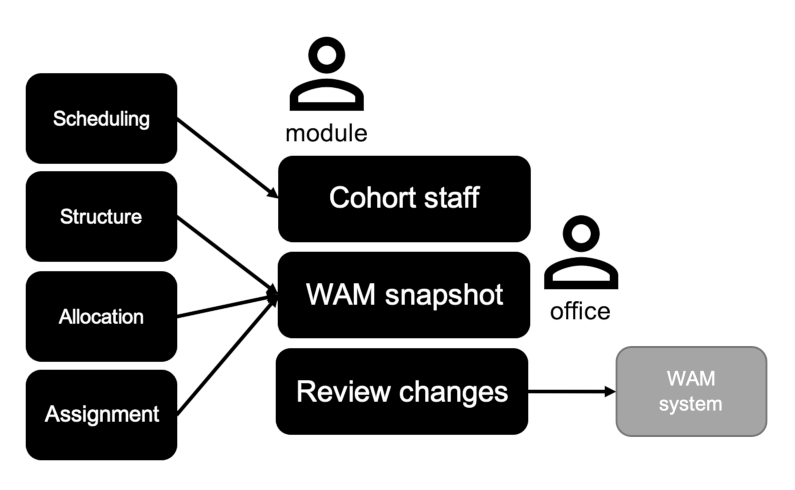Processes
The individual features of Mentor are linked in several different ways. Although they can be described individually, it is more useful to see them in the context of a small number of major processes.
Each process requires input from various sources, and delivers output in various forms. The input information tends to be quite dynamic, and process therefore need to be though of as iterative.
Scheduling
The academic year and trimester dates are one of the most fundamental pieces of data in Mentor. Almost all other processes rely on this data being correct.

The second part of the scheduling process is related to the maintenance of cohort information. The planning and assignment processes both reply on the list of students in each cohort being up to date. The students in a cohort may be input manually, but they can also be imported from a spreadsheet such as those that can be produced from SITS.
When a cohort is imported, a stub record is created for any programmes that have not been encountered previously. These new programme records must be completed manually.
Planning
Before the start of the academic year, Heads of Subject (HoS) need to consider the resource requirements for the coming year and to decide how to allocate work to their staff.

Input for the planning process comes primarily from SITS and other University systems. There are two main steps:
- Estimating the number of students in each module cohort
- Allocating responsibilities to academic staff
The input data is imported into Mentor from spreadsheets and an automated process calculates an initial set of figures. The input data is not 100% accurate, however, and therefore the estimates need to updated manually. Detailed information on creating estimates can be found here.
The estimates need to be regenerated regularly in the run-up to the start of the academic year so that they reflect the most recent admissions data.
The estimate data is made available to HoS via the Allocate menu option. This page displays a grid with the group's academic staff down the left-hand side and the projected cohorts across the top. The estimated number of students (or groups) in each cohort is displayed at the bottom of the grid. This number is highlighted in red if the estimated number exceeds the current allocation. The challenge for the HoS is to adjust the allocation for each member of staff so that the estimated workload is covered.
A detailed description of the process and how to use the Allocate page can be found here.
The output of the planning process is used by the assignment process and by the system of spreadsheet used to plan resource allocation for other types of module.
Assignment
An assignment is a pairing of a student with a member of staff in a specific role. The input for this process can come from several sources including students and academic staff. Assignments can also arise from executive decisions by the ML themselves. In that case, the allocation data provided by HoS is a useful guideline to ensure that the appropriate members of staff are chosen.

In many cases, the ML may choose to do detailed management offline using local procedures. At present, any offline data has to be entered int Mentor manually one items at a time. A future enhancement will allow the ML to upload a spreadsheet containing assignment details.
Further details on assignment as be found here
WAM reporting
Mentor captures two kinds of WAM data. The first arises from the assignment of members of staff in particular roles for particular students; the second is related to the standard catgories of activity associated with a module (preparation, contact, assessment, leadership).

The data in Mentor changes often and sometimes unpredictably. In order to control the procedure for updating the WAM system, the data is frozen periodically as a series of snapshots. The data in a snapshot is calculated based on
- The cohort teaching team information
- The actual assignments associated with each member of staff
- The WAM value associated with a particular role
- The allocations defined for a member of staff by the Head of Subject
The first stage is for the Module Leader (ML) to define the teaching team for the cohort. This only needs to be done once aslong as the composition of the team does not change. On the other hand, many WAM snapshots may be created as the actual situation evolves.
Mentor compares a snapshot to the previous one and displays the changes from one to the other. This simplifies the process of transferring the data to the WAM system. Currently, the transfer process is manual, but it will be automated in a future enhancement.
Further detail on the WAM accounting process can be found here